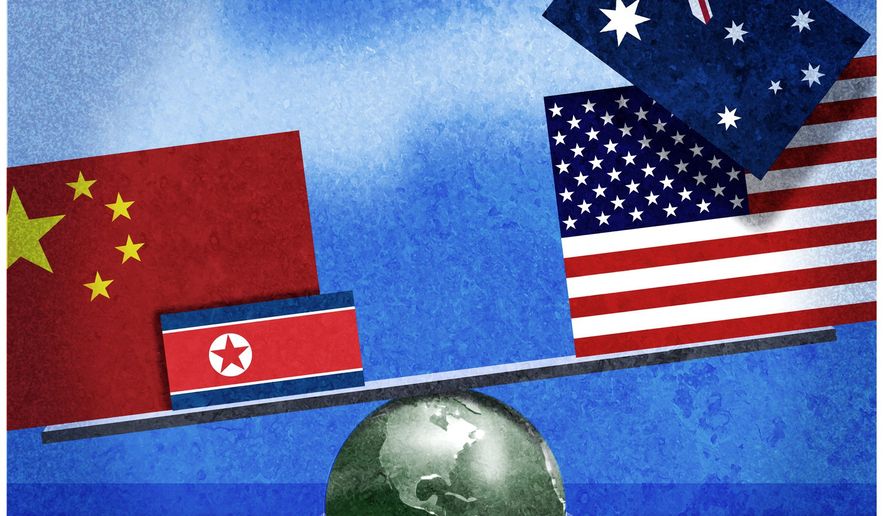OPINION:
President Trump’s engagement of North Korea and its intransigent and unpredictable dictator, Kim Jong-un, was a stunning departure from the staid and unproductive efforts of prior U.S. administrations.
Early on, the president’s application of “maximum pressure” to replace the previous failed “strategic patience” approach appeared fruitful. Mr. Kim halted a series of provocative nuclear and missile tests, particularly when economic sanctions took hold and brought much financial pain to his regime.
The Trump-Kim Singapore Summit in June 2018 brought promise. Their follow-up meeting eight months later was disappointing. Since then, Mr. Kim has become more emboldened, re-engaging in saber-rattling in what he now terms “positive and offensive measures for fully ensuring the sovereignty and security of the country.” It’s time for the United States to respond definitively and clearly to Mr. Kim — and his patron, China — that enough is enough.
The challenge Washington faces with Mr. Kim is that the fulcrum of influence between North Korea and the United States has shifted. It moved as a result of North Korea’s success in developing nuclear weapons and a slow yet steady decline in the U.S. military presence on the Korean peninsula that began in 1971 with the withdrawal of the 7th Infantry Division.
In 1989, further cuts to the 2nd Infantry Division in South Korea occurred. That downward trend has continued. North Korea has noticed. Moreover, the U.S. military presence in East Asia has also declined. After 1991, following the Philippine Senate’s refusal to permit continued U.S. access to the sprawling Subic Bay Naval Base and Clark Air Force Base, our influence in the region was further degraded. China noticed.
Now President Trump should take notice of the value of forward-deployed forces in asserting U.S. influence in securing our vital national interest in East Asia, including freedom of navigation, deterred aggression and nuclear nonproliferation.
The reduction in U.S. forces in South Korea over time clearly signaled that the United States was disinclined to engage in land combat on the Korean peninsula, despite the rising threat from North Korea’s nuclear and missile proliferation.
Furthermore, the regrettable U.S. departure from the Philippines benefitted China, which has aggressively asserted its territorial claims to the oil-rich Spradley Islands lying between China, Malaysia, the Philippines and Vietnam, while demanding the U.S. Navy steer clear of nearby sea lanes.
That China feels thus emboldened says much about how it sees the influence fulcrum shifting in their favor with a reduced U.S. military presence of forward-deployed forces in the region. This should provide a lesson for President Trump’s policymakers.
Both Mr. Kim and China have taken measure of America’s withdrawal from East Asia. Both understand that as U.S. regional presence wanes, their ability to flex their muscles waxes. The value of forward-deployed forces was clear during the Cold War.
Indeed, it demonstrated our firm resolve to fight Soviet-Sino aggression wherever it might occur. This proposition is in doubt today and contributes to the perception that the United States lacks resolve in the region. The president’s wise employment of maximum pressure is not enough to assert U.S. influence in North Korea and the region to secure peace.
Even now Mr. Kim is creating new front companies — supported by Chinese banks — to circumvent sanctions. A strong forward-deployed presence — with robust allied cost-sharing — is essential in securing the undivided attention of North Korea and China, which think we are irresolute in pursuing our national interests. They must be disabused of this.
First, the United States should return two full U.S. Army divisions to South Korea with accompanying field artillery rocket brigades and missile defense units to effectively confront the threat of North Korean tactical artillery and missiles to South Korea.
Second, the United States should re-engage in robust U.S.-allied military exercises to demonstrate that if Mr. Kim seeks armed conflict, he will lose.
Third, the United States should initiate negotiations with the Philippines to restore our naval and air power projection in the region, making our intent clear to both Pyongyang and Beijing. It’s one thing for the United States to aspire to deterrence and freedom of navigation in the region. It’s entirely another to be a resident there.
Fourth, the United States should negotiate with our reliable ally, Australia, to develop a U.S.-Australian joint warfare training and testing center for forces and capabilities that may be called upon to confront armed aggression in East Asia. Given Australia’s abundant territory, the increased ranges of future U.S. munitions and our common interest in resisting Chinese aggression in the region, such joint training and testing would be beneficial.
The influence fulcrum shift favoring North Korea and China has accommodated increased Chinese aggression in the region as well as Mr. Kim’s continued brinkmanship. It’s time to set both straight and a resurgence of forward-deployed forces in the region is a vital step in deterring war, particularly endless ones President Trump earnestly seeks to avoid.
• L. Scott Lingamfelter, a retired U.S. Army colonel, combat veteran and Foreign Area Officer, served as a battalion commander in the 2nd Infantry Division.




Please read our comment policy before commenting.